Speaking of which, Rongchang should be the most “elegant and popular” area in Chongqing. There are “Rongchang pigs” that are down-to-earth and can fill their stomachs, and “Rongchang Xiabu”, which is full of intangible cultural heritage handicraft skills and full of elegance and charm. As a part of ancient Changzhou, Rongchang has been the main road connecting Bashu and Sichuan since ancient times. Perhaps this is the reason why the culture here is so diverse. Let’s go, along the Laixi River, and pick up the traces of time in the Begonia Fragrant Country.
See all the ancient eight scenic spots in one garden
Rongchang, located in the west of Chongqing and bordering Sichuan Province, is a place rich in gourmet food, a city that belongs to a mountain city but is flat.
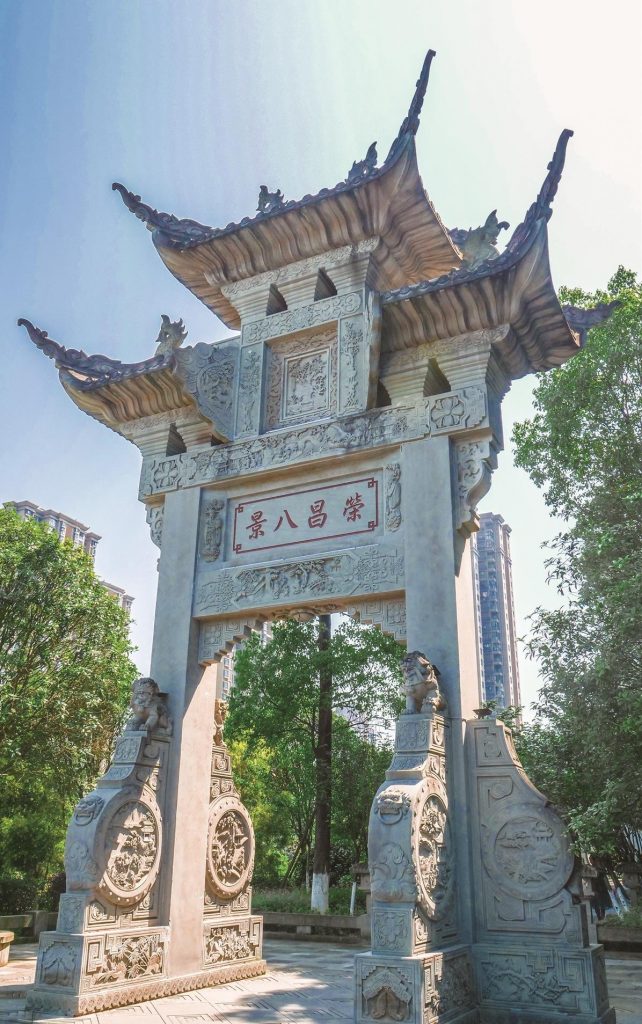
Ping is the first feeling that Rongchang is different from the main city of Chongqing. The city is located at the junction of the eastern Sichuan parallel ridge and valley area of the central Sichuan hills in the Sichuan Basin. The terrain is dominated by shallow hills, with gentle undulating terrain. The Laixi River runs through the city from south to north, which is a fertile soil for civilization.
According to historical records, in 758 AD, the first month of the second year of the Qianyuan year of the Tang Dynasty, Changzhou was established, under the jurisdiction of Changyuan, Jingnan, and Dazu counties. State seat. Because of the begonias planted all over the place and the fragrance of flowers, it is elegantly called Tangcheng and has the reputation of “Begonia Fragrant Country”. Hundreds of years ago, “Huguang filled Sichuan”, which allowed Rongchang to absorb various cultures and form a unique regional culture. It is recorded in the “Rongchang County Chronicle” of the Qing Dynasty that during the Qianlong period, a group of well-known figures in Rongchang gathered together and selected eight scenic spots with the best scenery in Rongchang, namely Tangyan Piaoxiang in Wujia Town and Taofeng in Fenggao Town. Jicui, Hongqiao Yinyue in Shiji Bridge, Longdong Qixia in Changlong Township, ancient Buddha Sleeping Cloud in Reclining Buddha Temple, Baoyan Waterfall in Qibaoyan, Shihang Qiushui in Renyi Town and Yayu Fairy Chess in the north of Anfu Town . Years of ups and downs, vicissitudes of life, some of these scenic spots still exist, and some have disappeared in the long river of history. Therefore, people today decided to choose a place in Rongchang City to recreate the ancient eight scenic spots to get a glimpse of the old scenery, and the Eight Views Garden was formed according to the situation.
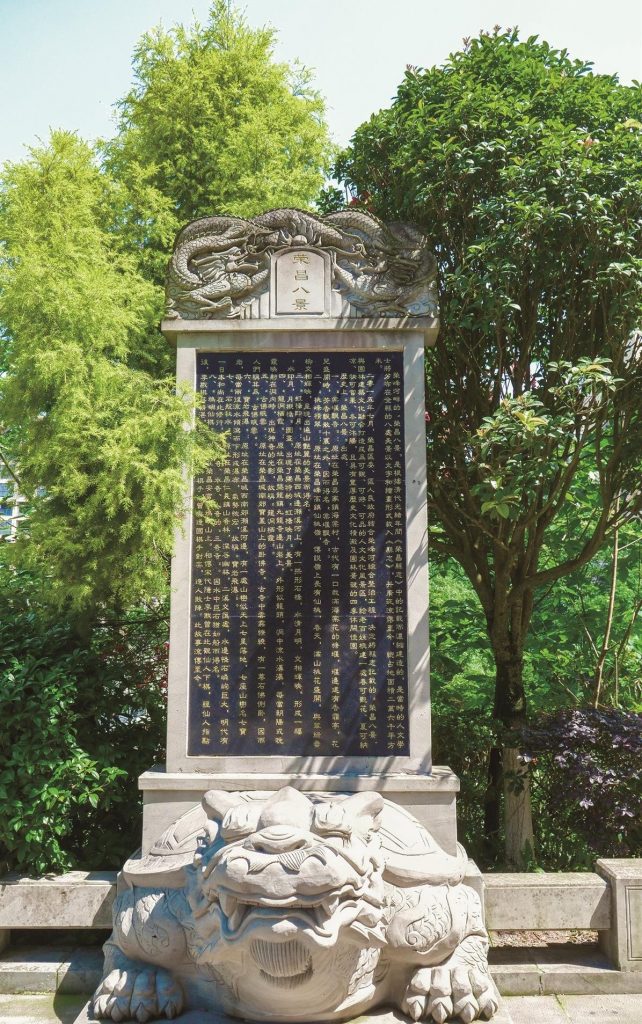
Bajing Garden is located on the bank of Rongfeng River, a national-level water conservancy scenic spot in Rongchang. According to the existing landscape and landforms, the eight famous scenic spots in ancient Rongchang recorded in the “Rongchang County Chronicle” during the Guangxu period of the Qing Dynasty are composed of stone masonry, plastic stone, rockery, and corridor. , pavilions, trails, vegetation, stacked water and other elements for artistic reproduction. The poems and songs of “Eight Sceneries of Rongchang” are also added, which adds a bit of humanistic charm to the park. It is a good place to understand the natural charm of the city after arriving in Rongchang for the first time.
Entering the garden from the south gate of the Eight Views Garden on Guotai Road, and then going northwest along the Rongfeng River, you can find the ancient eight scenic spots one by one. The river in the park is quiet and flowing slowly, with lush green plants and growing along the banks. It has the feeling of “green trees and green vines, covered with swaying and swaying, and staggered.” described in Liu Zongyuan’s “Little Stone Pool”. “Tongzhi Rongchang County Chronicle” records: “In Wujiapu, 120 miles north of the county, there is Xiangfei Pavilion in the weir, and your Excellency has Xiangfei Bridge, so it is also an ancient scenic spot.” This is one of the eight ancient scenic spots in Rongchang. fragrant. In the garden in front of you, the Fragrance Pavilion is hidden among the strange rocks and branches, like a half-hidden shy girl, but the spring has passed, and the fragrance of crabapples is hard to find, only the water of the trickling river can relieve the heat of early summer. Not far away, among the green bamboos, people pass by an unnamed three-arch stone bridge from time to time. The stone walls of the bridge arches are shimmering with sparkling waves, which is a peaceful and quiet place that is hard to find in the city.
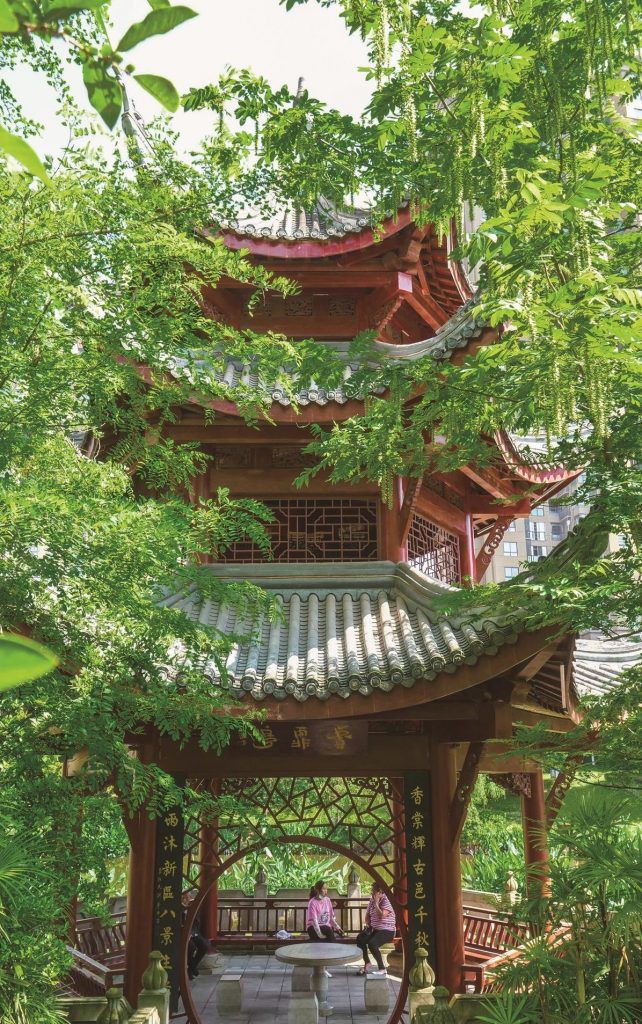
“Tingxie Yingfangxi invites friends to sing poetry through the ages, and candles, clouds, dragons and beautiful waters move into the four seasons of spring”, swim to the promenade of Guanyue Pavilion to rest, listen to old people chatting, stop in the poetry gallery, and read the poems carefully , Goodbye to the beauty of the eight scenes between the lines. On the opposite bank of the “Eight Views of Rongchang” Stele Square, there is a building in the shape of a ship, which looks like a “pirate ship” from a distance. Passing through the Eight Views Bridge, I walked in and found that this was supposed to be a shoreside viewing platform, but for some reason, it has been discontinued, and it has become a riverside scene instead.
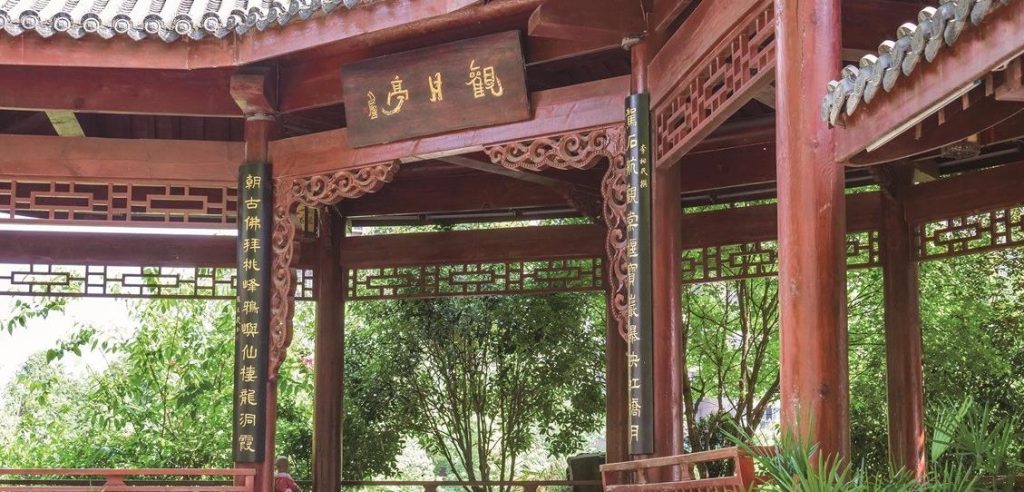
The “Three Treasures” of the intangible cultural heritage gathered in the town
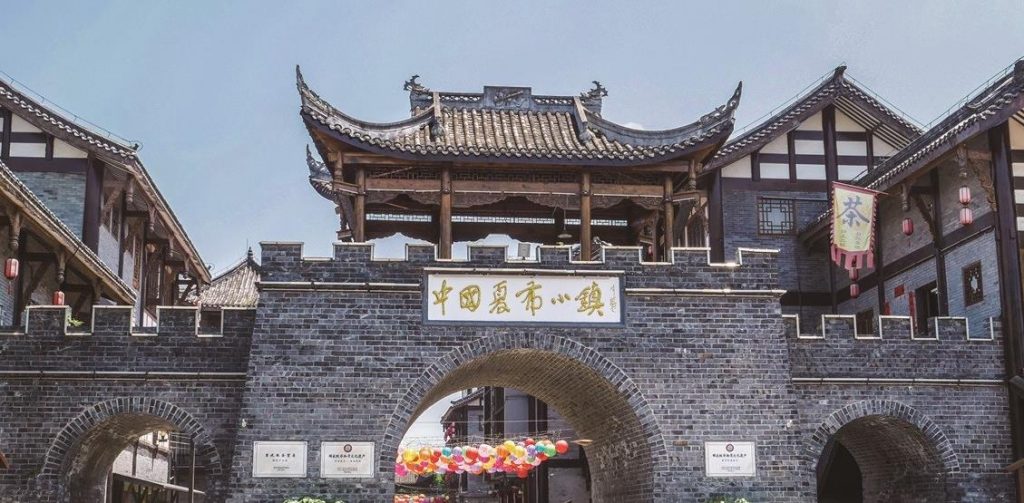
If Bajingyuan lets people touch Rongchang in Ming and Qing Dynasties through the text, then walk into Xiabu Town, in the process of getting to know the three intangible cultural heritages of Rongchang pottery, Rongchang Xiabu and Rongchang folding fan among the Four Treasures of Rongchang In the past, perhaps more deeply felt the prosperous years of Rongchang in the past thousand years.
Xiabu Town is a national AAA-level “intangible cultural heritage tourist attraction”. It is located in Changzhou Street where the Laixi River and Rongfeng River meet. It covers an area of more than 100 acres. The main building consists of 24 courtyards imitating the Ming and Qing Dynasties. Qingwa Ancient Courtyard, Yimeng Covered Bridge, horizontal and vertical trails, and pottery pots all over the place. Walking into the small town of Xiabu, I saw that the ramie in the flowerpot was thriving. The early summer sunshine fell in front of the town’s houses on the street, shone through the glass windows and fell into the windows of various shops, making people can’t wait to walk into Xiabu. style. However, before frantically “chopping hands”, you can go to the Shabu Museum in the town to learn about Shabu’s past and present.
The Shabu Museum is located in the center of Shabu Town, with a total of two floors. The first floor mainly displays the production process of Xiabu, related tools and culture, and the second floor is divided into three parts: Xiabu history, Xiabu technology and Xiabu industry, telling the development of Xiabu from ancient times to the present. It turns out that Xiabu, also known as linen, is hand-woven from kudzu and hemp fibers. It was named Xiabu because it was often used to make summer clothes and mosquito nets in ancient times. The weaving technique of Rongchang summer cloth originated in the Warring States Period. During the period of “Huguang filling Sichuan”, the immigrants from Huguang brought advanced cultivation and hemp weaving techniques, and the summer cloth was revived in Rongchang and other places again.
Walking in the hall, planting hemp, bleaching, tearing, rolling, twisting… The ramie fibers on the loom are neatly arranged one by one, waiting for the technicians to weave them into “light as cicada wings, thin as rice paper, flat as water mirrors” , as fine as silk” Rongchang Xiabu. The silk thread shuttles on the flywheel, and the people standing in front of the loom can also start a dialogue with history. It is worth mentioning that in recent years, the people of Rongchang have continued to develop and innovate, and they have explored new products for the quantification of the summer cloth industry and artistic reconstruction, such as summer cloth brooches, hats, clocks, fashion and so on. Years flow at the fingertips, and ingenuity continues with the ancient charm. Looking at the bright fashions on the models, I know that today’s summer cloth products have been successfully integrated into people’s daily life, from clothing to accessories, and they are also active on the fashion week and other stages with their own brands, walking at the forefront of fashion.
After visiting the complete process of shabu production, if you are in high spirits, you can also ask the inheritor of Shabufei for some advice, tie-dye a unique shabu handkerchief, draw a shabu painting, and make a shabu flower to commemorate this trip. Unique travel. The Yiqiutang Xiabufang and Jiahe Xiabu in the town both provide Xiabu making experience services, and also sell related products. The experience service of Yiqiutang mainly focuses on the production of summer cloth, which needs to be reserved in advance and taught by non-genetic inheritors; the experience of Jiahe Xia cloth is more abundant.
Of course, the elegance of Shabu Town does not stop there. Go to the Yimeng Gallery Bridge and listen to the non-hereditary inheritors tell the secrets of Xiabu on the banks of the Rongfeng River; go to the Wanfan Hall to see the craftsman’s skillful hand flying and making a light and agile handle, with lines that are round on the outside and square on the inside. The bright and smooth Rongchang folding fan; stroll to the Micro Art Museum (Shuangyitang) on the south bank to appreciate the calligraphy and painting works of Mr. Xie Yongcai, the vice chairman of the Rongchang District Calligraphers Association and other calligraphers and painters in Chongqing. Antao Town, which is famous for pottery making, has established cooperation and will open a Rongchang pottery making experience shop in Shabu Town. At that time, Rongchang’s “intangible cultural heritage” three treasures (folding fans, pottery, Xia cloth), a small town can be “packaged”.
Changzhou Hometown Begonia Fragrance
At noon, the sun began to become a little hot and scorching, drying the leaves by the roadside brightly, and the fragrance of plants in the air was accompanied by the spice of spices. After leaving the town of Xiabu, go along the Laixi River to the hometown of Changzhou near the residential area to look for traces of the Begonia Fragrant Country.
Ancient Changzhou was the beginning of the establishment of counties in Yongchuan, Dazu and Rongchang. Because of the unique fragrance of begonia, this place has been well-known in the Tang Dynasty, and has the reputation of “Begonia Fragrant Country”. Today, Rongchang, Yongchuan, and Dazu have all built the ancient city of Changzhou. Who was the seat of the state capital in the past? Unpredictable.
The Changzhou Hometown Scenic Spot in Rongchang was built in 1981. After successive expansions, the scenic spot now covers an area of more than 500 acres and consists of nineteen unique courtyard houses. There are green grass and green trees on the edge, and two ancient stone arch bridges built in the Ming Dynasty on the river, Guanyin Bridge and Xiaotan Bridge, lie in between. Behind it is the beautiful natural scenery of Haitang Park, which reproduces the prosperous scene of “nine palaces and eighteen palaces and three thousand seven hundred towers” in ancient Changzhou. , style restaurant, house hotel “the ancient street of Ming and Qing Dynasties”.
There are Zhang Peijue Memorial Hall, Rongchang Martyrs Cemetery, Chunhui Pavilion, Lotus Pond Sandie, Xiangfei Tower and other major attractions in the scenic area. The houses with white walls and black tiles are hidden among the green trees and lakes. Walking in the middle is like swimming in the middle of a painting” poetic and picturesque. The Xiangfei Tower and the Zhang Peijue Memorial Hall are especially worth seeing.
Xiangfei Building is built on a hill at the end of Changzhou’s hometown scenic spot, which is much higher than the surrounding buildings. It can be seen in the town of Xiabu. If you can climb the Xiangfei Building and overlook it, you will be able to enjoy the beauty of Rongchang City. Close your eyes. However, this place is not currently open, and you can only tour around and look up at the majestic buildings. The Zhang Peijue Memorial Hall is composed of four parts: Zhang Peijue and the 1911 Revolution Exhibition Hall, Zhang Peijue Tomb, Zhang Peijue Bronze Statue, and Zhang Peijue Memorial Square. The memorial hall introduces in detail Zhang Peijue’s short but great life experience since he joined the Tongmenghui, determined to dedicate himself to the revolutionary cause of overthrowing the monarchy and establishing the Republic of China, and was later killed by Yuan Shikai’s government. Wandering in the memorial hall, the reverence for the martyrs and the cherishing of peace arise spontaneously.
If you are tired from walking, you can eat all kinds of food in the scenic area. Chinese food, hot pot, special dishes, taverns, tea shops, fish farms, taverns, cloth farms, pharmacies and other shops are lined up. There are also many local snacks such as Yeerba, yellow jelly, and braised white goose with Rongchang characteristics. taste.
After feasting your eyes and mouth in the ancient city of Changzhou, you might as well take a walk to the Rongchang Catholic Church to digest your food. This church is located on West Street, Rongchang City, Chongqing. It is commonly known as Rongchang Catholic Church. The main church is 50 meters high and covers an area of more than 4,700 square meters. It is a Gothic building designed and built by the French in 1915. The best preserved church, Feng Xiaogang’s film “1942” was also shot here. Walking into the church, many of the objects inside have been dilapidated, mottled and faded. The moss in the corners, the echoes of the empty space and the gentle evening breeze make people feel the sighs of the ancients this month.
When the lanterns are on, and the Laixi River is romantic and gentle at night, let’s go home with the red sunset…
Comments